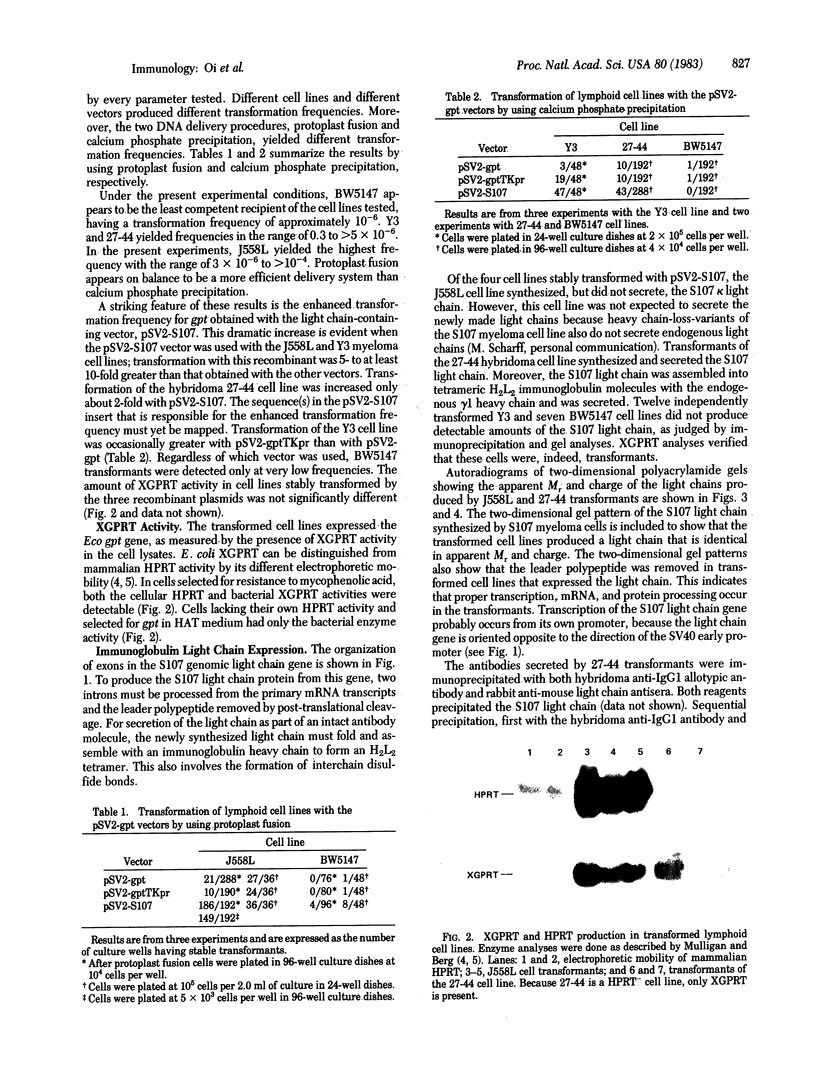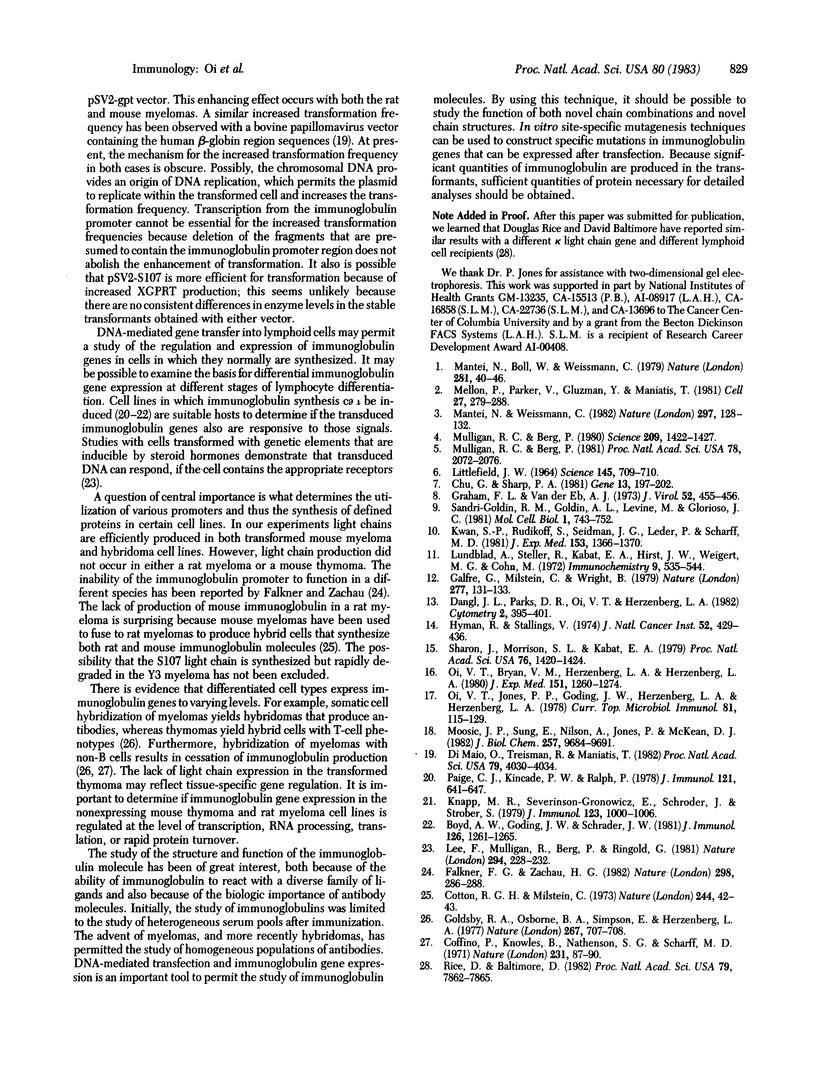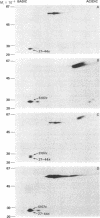Abstract
Myeloma, hybridoma, and thymoma cell lines have been successfully transfected for the Escherichia coli xanthine-guanine phosphoribosyltransferase gene (gpt) by using the plasmid vector pSV2-gpt. The transformed cells synthesize the bacterial enzyme 5-phospho-alpha-D-ribose-1-diphosphate:xanthine phosphoribosyltransferase (XGPRT; EC 2.4.2.22) and have been maintained in selective medium for over 4 months. Lymphoid cell lines expressing a K immunoglobulin light chain were obtained by transfecting cells with pSV2-gpt containing a rearranged K light chain genomic segment from the S107 myeloma cell line. The S107 light chain is synthesized in gpt-transformed J558L myeloma cells and is identical to the light chain synthesized by the S107 myeloma cell line, as judged by immunoprecipitation and two-dimensional gel electrophoresis. Furthermore, this light chain is synthesized and secreted as part of an intact antibody molecule by transformed hybridoma cells that normally secrete an IgGl (gamma, K) antibody molecule. No light chain synthesis was detected in a similarly transformed rat myeloma or a mouse thymoma line.
Full text
PDF




Images in this article
Selected References
These references are in PubMed. This may not be the complete list of references from this article.
- Coffino P., Knowles B., Nathenson S. G., Scharff M. D. Suppression of immunoglobulin synthesis by cellular hybridization. Nat New Biol. 1971 May 19;231(20):87–90. doi: 10.1038/newbio231087a0. [DOI] [PubMed] [Google Scholar]
- Cotton R. G., Milstein C. Letter: Fusion of two immunoglobulin-producing myeloma cells. Nature. 1973 Jul 6;244(5410):42–43. doi: 10.1038/244042a0. [DOI] [PubMed] [Google Scholar]
- Dangl J. L., Parks D. R., Oi V. T., Herzenberg L. A. Rapid isolation of cloned isotype switch variants using fluorescence activated cell sorting. Cytometry. 1982 May;2(6):395–401. doi: 10.1002/cyto.990020607. [DOI] [PubMed] [Google Scholar]
- DiMaio D., Treisman R., Maniatis T. Bovine papillomavirus vector that propagates as a plasmid in both mouse and bacterial cells. Proc Natl Acad Sci U S A. 1982 Jul;79(13):4030–4034. doi: 10.1073/pnas.79.13.4030. [DOI] [PMC free article] [PubMed] [Google Scholar]
- Falkner F. G., Zachau H. G. Expression of mouse immunoglobulin genes in monkey cells. Nature. 1982 Jul 15;298(5871):286–288. doi: 10.1038/298286a0. [DOI] [PubMed] [Google Scholar]
- Galfrè G., Milstein C., Wright B. Rat x rat hybrid myelomas and a monoclonal anti-Fd portion of mouse IgG. Nature. 1979 Jan 11;277(5692):131–133. doi: 10.1038/277131a0. [DOI] [PubMed] [Google Scholar]
- Goldsby R. A., Osborne B. A., Simpson E., Herzenberg L. A. Hybrid cell lines with T-cell characteristics. Nature. 1977 Jun 23;267(5613):707–708. doi: 10.1038/267707a0. [DOI] [PubMed] [Google Scholar]
- Graham F. L., van der Eb A. J. A new technique for the assay of infectivity of human adenovirus 5 DNA. Virology. 1973 Apr;52(2):456–467. doi: 10.1016/0042-6822(73)90341-3. [DOI] [PubMed] [Google Scholar]
- Hyman R., Stallings V. Complementation patterns of Thy-1 variants and evidence that antigen loss variants "pre-exist" in the parental population. J Natl Cancer Inst. 1974 Feb;52(2):429–436. doi: 10.1093/jnci/52.2.429. [DOI] [PubMed] [Google Scholar]
- Knapp M. R., Severinson-Gronowicz E., Schröder J., Strober S. Characterization of a spontaneous murine B cell leukemia (BCL1). II. Tumor cell proliferation and IgM secretion after stimulation by LPS. J Immunol. 1979 Sep;123(3):1000–1006. [PubMed] [Google Scholar]
- Kwan S. P., Rudikoff S., Seidman J. G., Leder P., Scharff M. D. Nucleic acid and protein sequences of phosphocholine-binding light chains. J Exp Med. 1981 May 1;153(5):1366–1370. doi: 10.1084/jem.153.5.1366. [DOI] [PMC free article] [PubMed] [Google Scholar]
- LITTLEFIELD J. W. SELECTION OF HYBRIDS FROM MATINGS OF FIBROBLASTS IN VITRO AND THEIR PRESUMED RECOMBINANTS. Science. 1964 Aug 14;145(3633):709–710. doi: 10.1126/science.145.3633.709. [DOI] [PubMed] [Google Scholar]
- Lee F., Mulligan R., Berg P., Ringold G. Glucocorticoids regulate expression of dihydrofolate reductase cDNA in mouse mammary tumour virus chimaeric plasmids. Nature. 1981 Nov 19;294(5838):228–232. doi: 10.1038/294228a0. [DOI] [PubMed] [Google Scholar]
- Lundblad A., Steller R., Kabat E. A., Hirst J. W., Weigert M. G., Cohn M. Immunochemical studies on mouse myeloma proteins with specificity for dextran or for levan. Immunochemistry. 1972 May;9(5):535–544. doi: 10.1016/0019-2791(72)90063-8. [DOI] [PubMed] [Google Scholar]
- Mantei N., Boll W., Weissmann C. Rabbit beta-globin mRNA production in mouse L cells transformed with cloned rabbit beta-globin chromosomal DNA. Nature. 1979 Sep 6;281(5726):40–46. doi: 10.1038/281040a0. [DOI] [PubMed] [Google Scholar]
- Mantei N., Weissmann C. Controlled transcription of a human alpha-interferon gene introduced into mouse L cells. Nature. 1982 May 13;297(5862):128–132. doi: 10.1038/297128a0. [DOI] [PubMed] [Google Scholar]
- Mellon P., Parker V., Gluzman Y., Maniatis T. Identification of DNA sequences required for transcription of the human alpha 1-globin gene in a new SV40 host-vector system. Cell. 1981 Dec;27(2 Pt 1):279–288. doi: 10.1016/0092-8674(81)90411-6. [DOI] [PubMed] [Google Scholar]
- Moosic J. P., Sung E., Nilson A., Jones P. P., McKean D. J. The selective solubilization of different murine splenocyte membrane fractions with lubrol WX and triton X-100 distinguishes two forms of Ia antigens. A cell surface (alpha, beta) and an intracellular (alpha, Ii, beta). J Biol Chem. 1982 Aug 25;257(16):9684–9691. [PubMed] [Google Scholar]
- Mulligan R. C., Berg P. Expression of a bacterial gene in mammalian cells. Science. 1980 Sep 19;209(4463):1422–1427. doi: 10.1126/science.6251549. [DOI] [PubMed] [Google Scholar]
- Mulligan R. C., Berg P. Selection for animal cells that express the Escherichia coli gene coding for xanthine-guanine phosphoribosyltransferase. Proc Natl Acad Sci U S A. 1981 Apr;78(4):2072–2076. doi: 10.1073/pnas.78.4.2072. [DOI] [PMC free article] [PubMed] [Google Scholar]
- Oi V. T., Bryan V. M., Herzenberg L. A., Herzenberg L. A. Lymphocyte membrane IgG and secreted IgG are structurally and allotypically distinct. J Exp Med. 1980 May 1;151(5):1260–1274. doi: 10.1084/jem.151.5.1260. [DOI] [PMC free article] [PubMed] [Google Scholar]
- Oi V. T., Jones P. P., Goding J. W., Herzenberg L. A., Herzenberg L. A. Properties of monoclonal antibodies to mouse Ig allotypes, H-2, and Ia antigens. Curr Top Microbiol Immunol. 1978;81:115–120. doi: 10.1007/978-3-642-67448-8_18. [DOI] [PubMed] [Google Scholar]
- Paige C. J., Kincade P. W., Ralph P. Murine B cell leukemia line with inducible surface immunoglobulin expression. J Immunol. 1978 Aug;121(2):641–647. [PubMed] [Google Scholar]
- Rice D., Baltimore D. Regulated expression of an immunoglobulin kappa gene introduced into a mouse lymphoid cell line. Proc Natl Acad Sci U S A. 1982 Dec;79(24):7862–7865. doi: 10.1073/pnas.79.24.7862. [DOI] [PMC free article] [PubMed] [Google Scholar]
- Sandri-Goldin R. M., Goldin A. L., Levine M., Glorioso J. C. High-frequency transfer of cloned herpes simplex virus type 1 sequences to mammalian cells by protoplast fusion. Mol Cell Biol. 1981 Aug;1(8):743–752. doi: 10.1128/mcb.1.8.743. [DOI] [PMC free article] [PubMed] [Google Scholar]
- Sharon J., Morrison S. L., Kabat E. A. Detection of specific hybridoma clones by replica immunoadsorption of their secreted antibodies. Proc Natl Acad Sci U S A. 1979 Mar;76(3):1420–1424. doi: 10.1073/pnas.76.3.1420. [DOI] [PMC free article] [PubMed] [Google Scholar]





